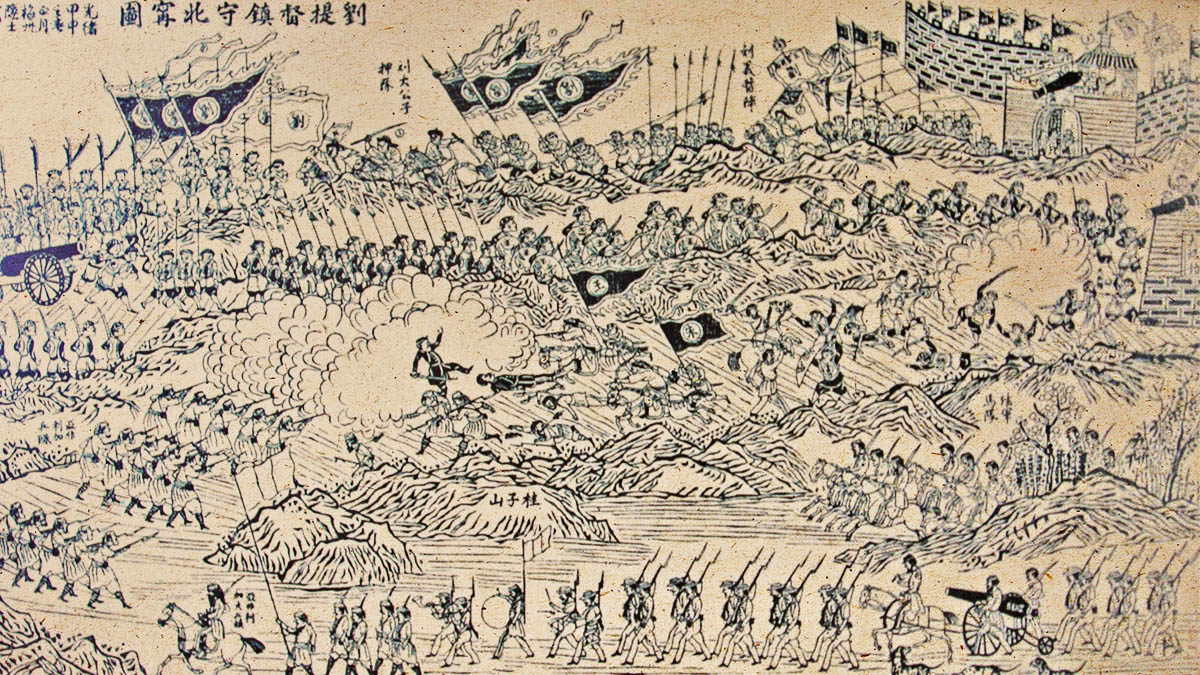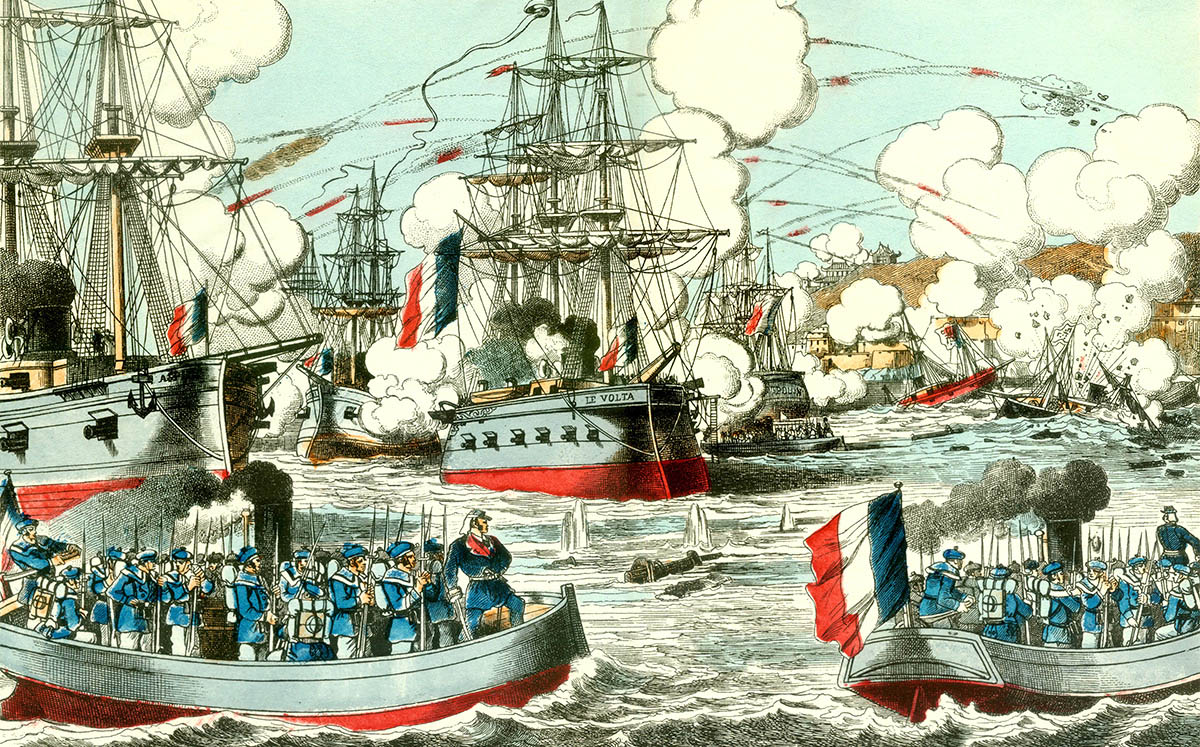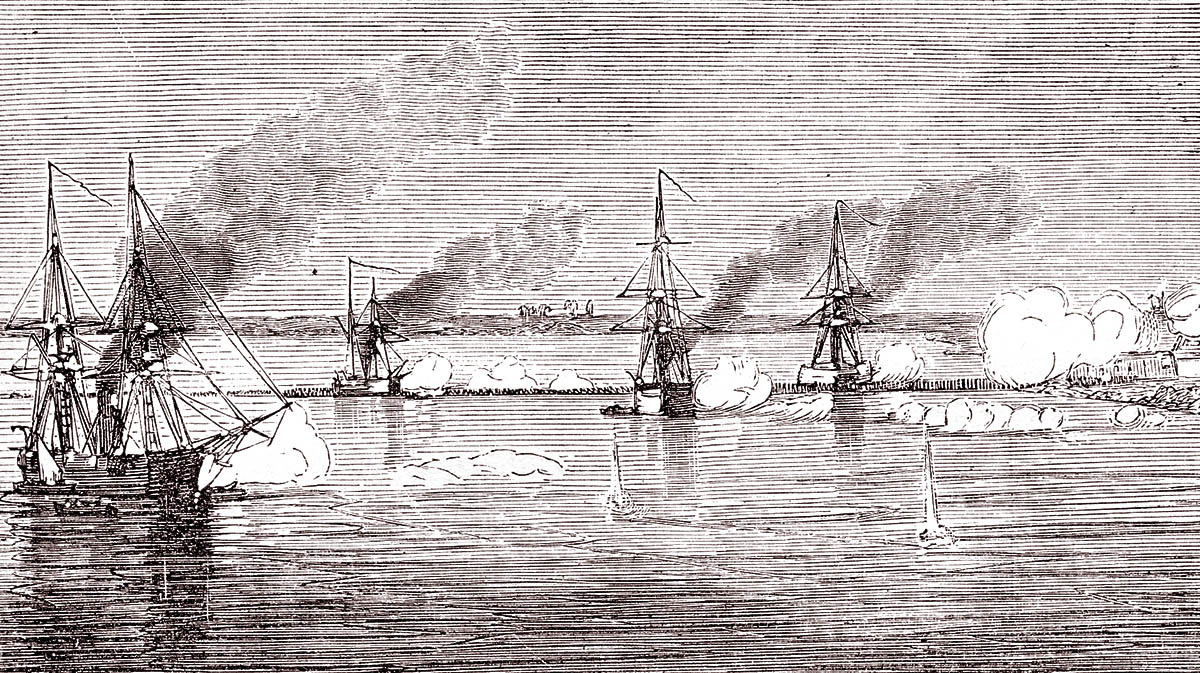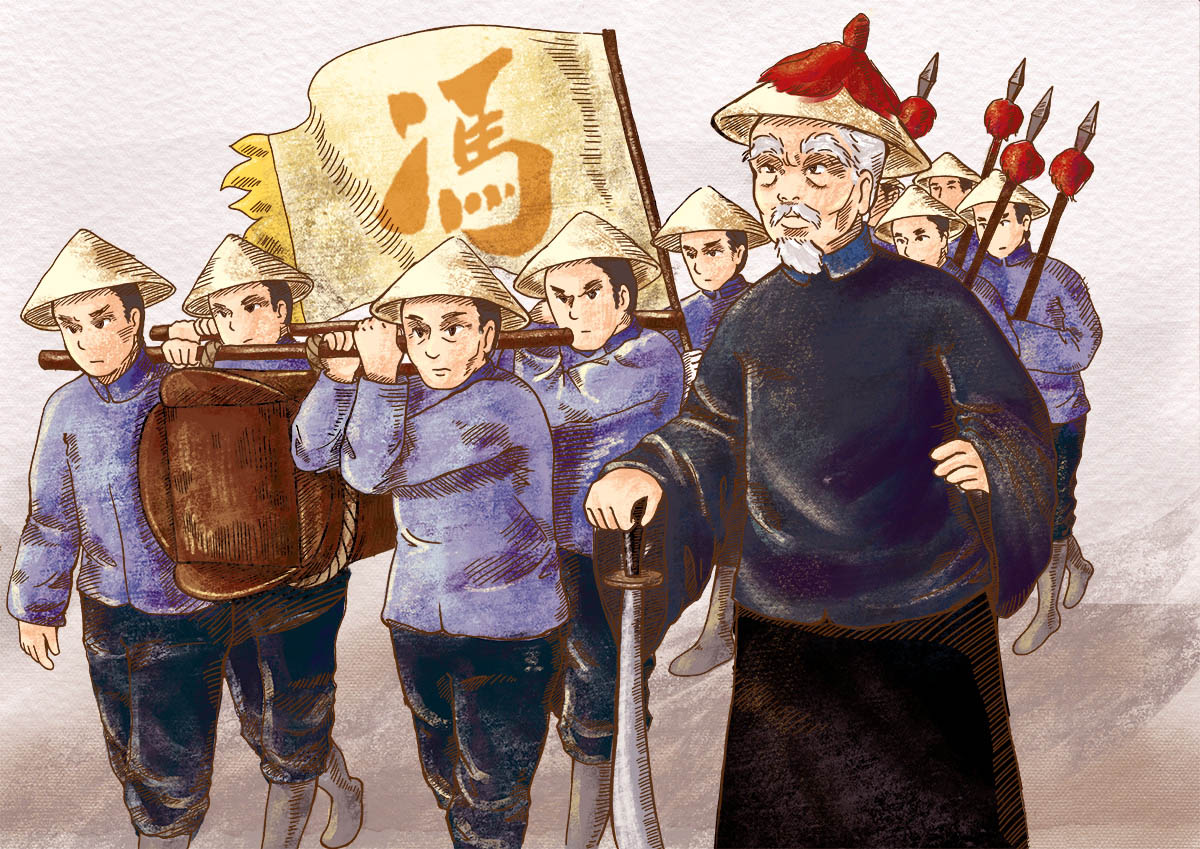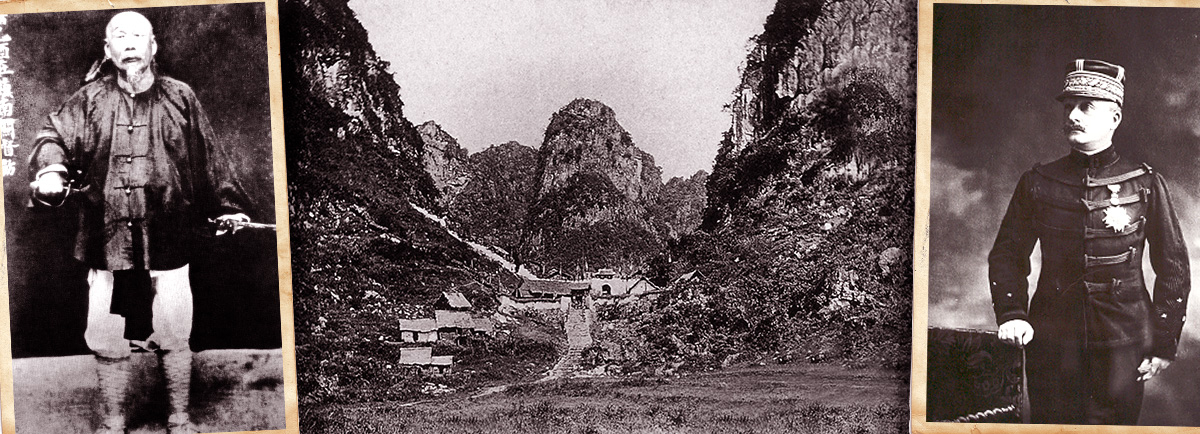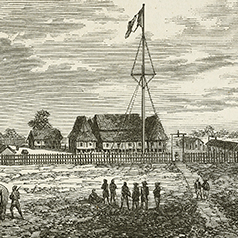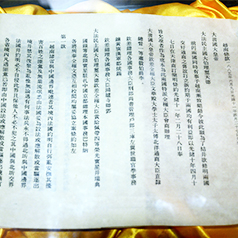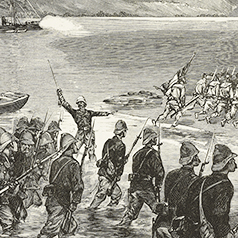In December 1883, the French military in Sơn Tây, Vietnam, started advancing towards the encampments of the Black Flag Army (黑旗軍) and the Qing military. This marked the beginning of the Sino-French War. The one-and-a-half-year long war can be broadly divided into three phases:
(1) Land campaigns in the early phase: the French initiated the Battle of Sơn Tây in December 1883, which pitted the French military against the Black Flag Army and the Qing military. This was followed by the Battle of Bắc Ninh in March 1884, another French-initiated battle. China performed poorly in both battles, which led to the signing of the Tientsin Accord (《中法會議簡明條約》, Tientsin also known as Tianjin) on 11 May 1884 by the Chinese representative Li Hongzhang (李鴻章) and the French representative François Ernest Fournier. The Tientsin Accord required China to stand aloof from the treaties between France and Vietnam.
(2) The middle phase was dominated by land-sea campaigns and mainly sea campaigns: in June 1884, France and Vietnam signed the second Treaty of Huế. Shortly afterwards, conflict broke out again in Bắc Lệ when the French military shelled the Qing military stationed near Lạng Sơn. Meanwhile, France also took the war to the south-eastern coast of China by sending naval ships led by Admiral Amédée Courbet to Fujian (福建) and Taiwan (台灣). In August 1884, the French forces occupying Keelung (基隆) in Taiwan were driven back to the sea by the Qing forces led by Liu Mingchuan (劉銘傳). On 23 August, the French navy launched a sudden attack on Majiang (馬江) in Fuzhou (福州), and succeeded in annihilating the Fujian Fleet (福建水師) and the Mawei Shipyard (馬尾船廠) of the Fuzhou Arsenal (福州船政局). They then proceeded to blockade Taiwan by sea and occupy Keelung and Tamsui (淡水). In March 1885, the French forces captured the islands of Penghu (澎湖) but were repulsed in a naval battle that took place in Zhenhai (鎮海), Zhejiang Province (浙江). In June, Admiral Courbet died of illness in Penghu.
(3) A return to land campaigns in the final phase: in March 1885, after capturing Lạng Sơn in Vietnam, the French military headed straight for the China-Vietnam border, where they clashed with the Qing military led by the elderly general Feng Zicai (馮子材). The French suffered an overwhelming defeat in this battle resulting in more than a thousand casualties. Triumphant, the Qing forces swept on to Lạng Sơn and retook it. Meanwhile, under Liu Yongfu’s (劉永福) command, the Black Flag Army also scored victories near Lâm Thao in Vietnam and recovered around a dozen counties. The battle at Zhennan Pass (鎮南關) turned the tide of the entire war.
|
|
The Fuzhou naval administration and its navy were products of the Self-Strengthening Movement. What did their failure signify? |
|
|
See answer below. |
The Chinese and French military in Vietnam were armed and ready for the imminent war. In December 1883, an augmented French army departed Hanoi to capture Sơn Tây, signifying the beginning of the Sino-French War.
An illustration titled Commander Liu Defends Bắc Ninh (《劉提督鎮守北甯圖》). It is dated “Guangxu Jiashen”( 光緒甲申), meaning 1884. The illustration depicts the battle between the French force and Liu Yongfu’s Black Flag Army in Bắc Ninh, a city east of Hanoi in Vietnam. The Black Flag Army was Vietnam’s staunch defender against the French before and long after the outbreak of the Sino-French War.
At the beginning of the Sino-French War, the French military scored victories near Sơn Tây and Bắc Ninh. In a bid to stop the war from spreading, the Qing government sent Li Hongzhang to negotiate with the French on 11 May 1884. The two parties signed the Tientsin Accord (pictured) in which China agreed to stand aloof from the treaties between France and Vietnam, which was tantamount to a recognition of Vietnam as a French protectorate. In June, France forced Vietnam into signing the second Treaty of Huế, in effect denying China’s suzerainty over Vietnam.
The initial military victory and successful conclusion of a beneficial treaty prompted France to launch an even larger attack. In early August of 1884, a French fleet under Admiral Amédée Courbet’s command attacked Taiwan. They first targeted Keelung (pictured) on 5 August, but were repulsed by the Qing forces under Liu Mingchuan, an imperial inspector minister of military affairs. The confrontation was known as the first Battle of Keelung.
After their thwarted invasion of Taiwan, the French changed course for Fujian. On 23 August 1884, the French fleet launched a sudden attack on Mawei in Fuzhou. Overwhelming the Fujian Fleet with their heavy naval gunfire, the French won a complete victory.
The Mawei Naval Battle, also called the Majiang (馬江) Naval Battle, was the first major naval battle between the new Chinese navy established during the Self-Strengthening Movement and a foreign navy. The battle was a short and one-sided one that resulted in the total loss of the Fujian Fleet. The French fleet also destroyed the shore battery and the Mawei shipyard in the Fuzhou Arsenal, which in effect allowed the French to control the waters off Fujian and the Taiwan Strait, endangering Fujian and Taiwan. The defeat showed that the Self-Strengthening Movement failed to fortify the national coastal defences effectively despite the 20-plus years of reform since 1860.
The French followed up their victory in the Mawei Naval Battle by advancing on Taiwan while attacking Penghu simultaneously. At one point, they occupied Keelung, Tamsui, and Penghu. Pictured is the French fleet shelling Penghu’s Magong Isle (馬公島) in March 1885.
While the French navy scored victories in Fujian and Taiwan, they were routed in the Battle of Zhenhai in Zhejiang, claiming numerous lives due to strong military and civilian resistance in Taiwan and Penghu. Meanwhile, the French were dealt a heavy blow by the outbreak of cholera. Scores of French officers, including Admiral Courbet, contracted while stationed in Penghu. In June 1885, Courbet died in Penghu and his body was shipped back to France.
Besides winning a string of naval victories, the French forces also made progress in their land campaigns. It enabled them to push northward from Vietnam, putting southern China in danger. This undesirable situation prompted the Qing government to summon back the retired general Feng Zicai to service. To demonstrate his resolve to resist the French with his life, Feng brought his own coffin along with him as he set forth to battle.
Feng Zicai had already retired from military duty in 1882 but was brought back into service on the recommendation of Zhang Zhidong (張之洞), the then Viceroy of Liang Guang (兩廣總督), due to China’s dire situation in the Sino-French War. By rising to the occasion in his twilight years and showing his resolve to do his duty at the risk of death, Feng inspired his troops and greatly bolstered their morale.
On 13 February 1885, the French military under General François Oscar de Négrier captured Lạng Sơn, a key location in northern Vietnam. They then marched straight to Zhennan Pass, a strategic point on the China-Vietnam border. Prior to the Battle of Zhennan Pass, as a commender, Négrier had not suffered a single defeat in his military career.
From the left: Feng Zicai, Zhennan Pass, François Oscar de Négrier. Zhennan Pass, a major passage perching on the China-Vietnam border during the Qing dynasty, was also called the “gateway to southern China”. It carried exceptional strategic significance. After taking Lạng Sơn, the French army under Négrier pressed onto Zhennan Pass where Feng’s forces armed and waited. An all-out war was set to erupt.
From 23 to 24 March 1885, the two forces engaged in fierce battle, with Feng Zicai personally entering the fray to engage the enemy. In the end, the French force were vanquished. China’s overwhelming victory at Zhennan Pass finally turned the tide of the war, allowing the Qing force to reverse its previous unfavourable position. While they could have followed up their victory by advancing south, the Qing government avoided military conflict and sought peace negotiations instead. Thus, they passed up a major opportunity to press home their advantage.
On 23 March 1885, the 46-year-old François Oscar de Négrier made the first move by shelling Zhennan Pass. The next day, the French force stormed the pass by three columns. The 67-year-old Feng Zicai, who was more than 20 years Négrier’s senior, charged into the French ranks with his two sons to engage the enemy. The sight of their commander leading the charge bolstered the Qing force’ morale, and all fought with great valour in the battle. Négrier, feeling complacent after achieving a string of victories in his Vietnam campaigns, believed that Zhennan Pass could be captured with ease. He decided to seize the momentum and press onto Guangxi Province (廣西). However, he did not expect the Qing force to put up an unusually ferocious resistance. After a two-day battle, the French force were in danger of being besieged. To extricate his troops from a potential deathtrap, Négrier was forced to order a retreat. As a commender, this was his first defeat. The French force fled south hastily and evacuated Lạng Sơn before the Qing force arrived. On 29 March, the Qing force recovered Lạng Sơn. Meanwhile, Liu Yongfu’s Black Flag Army also scored victories near Lâm Thao in Vietnam and recovered a dozen counties. Shaken by the successive defeats, the disastrous loss of Lạng Sơn in particular, public sentiment turned against Jules Ferry, the then French Prime Minister. This led to the collapse of his cabinet. Just as Feng was about to follow up his victory by leading a great host onto Hanoi, the Qing government was eager to make peace and negotiations, suspending Qing military’s operation.
|
|
The Fuzhou naval administration and its navy were products of the Self-Strengthening Movement. What did their failure signify? |
|
|
The foundation of a modern navy was one of the Self-Strengthening Movement’s top priorities since its commencement in 1860. The Fuzhou Arsenal, established in 1866 by Zuo Zhongtang (左宗棠) and operated by Shen Baozhen (沈葆楨), was one of the movement’s crowning achievements in its early phase. The arsenal served as an important base for the Fujian Fleet’s operations. Unfortunately, this remarkable accomplishment was wiped out during the Sino-French War. The Beiyang Fleet (北洋水師), another well-known Chinese fleet, was not founded until 1888. The disastrous failure of the Fuzhou naval administration exposed the movement’s fundamental weakness that of emulating Western military technologies without launching thorough reforms. However, the successors failed to reflect on and learn from the experience. This later led to the total annihilation of the Beiyang Fleet during a naval battle in the First Sino-Japanese War. |
Sources of most photos used in this feature piece: Visual China Group (pictures 1, 2 and 5), Fotoe (pictures 3 and 9), misc. photo sources.






